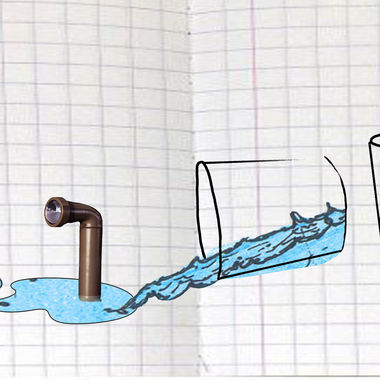Mon Mar 22 2021 · 13 min read
The Meghri Corridor: A Viable Transport Link or Geopolitical Noose?

By Garen Nazarian

Perhaps Armenia’s most serious economic and geopolitical handicap is that the country is landlocked. As if this were not a high enough hurdle, two of Armenia's four international borders, those with Turkey and Azerbaijan, have been closed to the movement of people, vehicles and goods since the 1990s. No one can dispute that real economic development and growth with borders closed to two of four neighboring countries is a difficult if not improbable task for a country with no access to open waters. Generally speaking it is in any country's economic interest to have cross-border ties with its neighbors. In Armenia’s case however, we must look beyond generalities and delve into specifics to assess the actual and potential geopolitical risks and benefits of reopening the borders with Azerbaijan through the revival of transport links as reflected in Article 9 of the November 10, 2020 ceasefire agreement that ended the 2020 Artsakh War.
The logical place to start this geopolitical excursion is the language of Article 9, which states:
All economic and transport links in the region shall be unblocked. The Republic of Armenia shall guarantee the safety of transport links between western regions of the Republic of Azerbaijan and the Nakhchivan Autonomous Republic with a view to organizing the unimpeded movement of citizens, vehicles and cargo in both directions. The Border Service of the FSB of Russia shall exercise control over the transport communication. Subject to agreement by the Parties, the construction of new infrastructure linking the Nakhchivan Autonomous Republic with regions of Azerbaijan shall be carried out.
Although Article 9 begins with a neutral and expansive statement that “all economic and transport links” shall be unblocked, only one is specifically noted – that between the exclave of Nakhichevan and the Republic of Azerbaijan through Armenia – the Meghri corridor, as it’s commonly called. Although Prime Minister Pashinyan and the Ministry of Foreign Affairs consistently maintain that neither "Meghri” nor “corridor" are in the ceasefire statement, there is no doubt it is precisely this particular transport link that is the center of attention. This was confirmed when Russian periodical Kommersant published a map after the January 11, 2021 meeting between the leaders of Armenia, Azerbaijan and Russia, where only the Meghri corridor transport link is pictured. From Armenia’s point of view, there are a few deeply worrying factors regarding Article 9, which on its face appears to bring Armenia out of regional isolation.
Detrimental Terms
First and foremost, it is crucial to consider that the genesis of the November 10, 2020 ceasefire agreement is Armenia’s clear defeat in the 2020 Artsakh War. Whether the trilateral agreement is technically a capitulation or not, nearly all its terms are detrimental to Armenia’s national interests. Other than the installation of Russian peacekeeping troops to stop the war and protect the Armenian population, only Article 8, regarding the exchange of prisoners of war is an indisputable benefit to Armenia - yet over four months after the end of the war, Azerbaijan still refuses to return all Armenian POWs. In fact, Azerbaijan still holds dozens of Armenian soldiers that were detained after the ceasefire was signed. At this point in time, Azerbaijan has not shown any real signs of deviating from its anti-Armenian policies. Shortly after the war ended, President Aliyev publicly stated that parts of the Republic of Armenia, including Yerevan and Syunik, historically belong to Azerbaijan. Also, in a thuggish move aimed at provoking Armenian citizens, there are now several large "Welcome to Azerbaijan" billboards placed along those portions of highway in Syunik which controversially reverted to Azerbaijani control after the war based on Soviet-era maps. Azerbaijan also announced a significant increase in its defense budget for 2021 - hardly an olive branch toward Armenia. Finally, Azerbaijan’s armed forces recently took part in war games of an offensive nature with the Turkish military in the Kars region – some 60 kilometers from Armenia’s border with Turkey.
The second worrying factor is that the Meghri corridor is the only link explicitly enumerated in Article 9, although there are other road and railway connections between the two countries that would currently be more beneficial to Armenia. That only the Meghri corridor is specifically named is a reflection of Azerbaijan’s victory in the war and the significance of this land link, above all others, for both Azerbaijan and Turkey. That Russia is also interested in this project for its own geopolitical reasons is obvious, given the time Putin has personally devoted and the speed with which the working group was formed and set to work. Clearly, all three of these countries are highly incentivized to make the Meghri corridor transport link a reality as soon as possible. For Azerbaijan, the benefit is clear – a direct link with its exclave of Nakhichevan, which has been a priority for Baku dating back to the days when ex-presidents Robert Kocharyan and Heidar Aliyev were negotiating potential solutions over Artsakh. For Turkey, the Meghri corridor opens up a direct connection with its ally Azerbaijan and the Turkic world beyond the Caspian Sea. For Russia, it weakens Georgia as a regional transport hub, provides a new rail link with Azerbaijan, Armenia and Turkey, and gives Russian security forces a new footprint in the South Caucasus. There is no doubt that the Meghri corridor is as much a geopolitical project as it is an economic one.
The main potential benefit to Armenia, if as stated in Article 9 all economic and transport links will be opened, is an alternate route for Armenian citizens and goods to and from Russia – an indispensable ally and trading partner of Armenia. The possible rail link with Iran through Nakhichevan is also a potential benefit, albeit a lesser one. As for the links with Azerbaijan opening up business and trade opportunities between the two countries, this seems unrealistic for the foreseeable future given the deep animosity that still exists. Currently, Armenia does not have any rail ties with Russia because the one that once operated through the region of Abkhazia is kept closed by Georgia due to its political strife with Russia. The only border crossing currently linking Armenia with Russia is a road through Georgia’s Upper Lars checkpoint, which is treacherous geographically and subject to intermittent closure due to bad weather and contentious geopolitics. It’s not uncommon for goods being transported from Armenia to Russia and vice versa to be stuck at this border crossing for extended periods of time.
Yet, there are road and railway links between Armenia and Azerbaijan, which are a much shorter route from Armenia to Russia, than the Meghri corridor route - which would require a train or car departing Yerevan to travel south through the entirety of Nakhichevan, east through Meghri, the southernmost tip of Armenia, westward through the entire southern region of Azerbaijan until the Caspian Sea, through Baku and then northward onto Derbent, Russia. Clearly, this many-hundred-kilometer journey, which requires travelling long distances south then east before heading north, is a curious way for Armenian goods and people to travel to Russia – especially with a neighbor who still views Armenia as an enemy country. It is important to remember that the war between Armenia and Azerbaijan ended with a ceasefire, not a peace treaty, which means the potential for future armed conflict cannot be ignored.
During Soviet times, a railway linking Armenia and Russia through Azerbaijan travelled from Yerevan to Dilijan and then Ijevan, through the Azerbaijani district of Gazakh to Baku and then into Russia. Although this rail link is currently not operational, it can be quickly revived because only a 500-meter section, which has been destroyed by landslides, needs to be rebuilt to make this route operational on the Armenian side of the border. Yet, time will tell if Azerbaijan will give the green light for this transport link to be re-established. Even if Azerbaijan agrees, Armenia will have to find the financing to make the necessary repairs and investments. Then, even if Armenia secures financing, Azerbaijan still has to be willing to guarantee safe passage of Armenian goods and citizens through its country. Under Article 9, Russian forces are to guarantee the unimpeded movement of goods and people across the Meghri corridor, which begs the question - who will give such guarantees and assurances to Armenia’s citizens and goods travelling across long swaths of Azerbaijan? Also, is there any incentive for Azerbaijan, still drunk from its victory in war, to provide an economic and political boost to Armenia by agreeing to a shorter rail and road link between Armenia and its military treaty partner Russia? Although Azerbaijan has publicly stated that the Karabakh issue is now resolved, this is clearly not the case given that Russian forces now protect the Armenian population in the three thousand square kilometers of NKAO that are still outside of Azerbaijani control. Given all these factors, it is difficult to agree with the optimistic view that the economic benefits of the Meghri corridor far outweigh the geopolitical risks from Armenia’s point of view.
No matter what Armenian officials claim about Armenia maintaining complete sovereignty over the Meghri corridor transport link, there is by definition loss of some sovereignty when a road and rail link moving across Country A, for the explicit purpose of linking citizens of Country B’s two territories, is controlled by the security agents of Country C. Of course, because this transport link will cross the Republic of Armenia, the land under the road and railway link will still legally belong to the Republic of Armenia. Yet, the sovereignty over this land will essentially be nominal if the terms outlined in Article 9 ever become reality because they cede control of the transport link to Russia for an undetermined and unstated period of time. The language in Article 9, that "[t]he Border Service of the FSB of Russia shall exercise control over the transport communication" explicitly gives Russia, not Armenia, control over the Meghri corridor. Thus, it is disingenuous for anyone to claim that Armenia will maintain full sovereignty unless this condition doesn’t survive any future final agreement. At the very least, the Armenian government must ensure that Article 9 has a sunset clause - meaning that, at some point in the future, full control and thus full sovereignty reverts back to Armenia.
Potentially Worrisome Scenarios
Now let us consider some potentially worrisome scenarios under the control/sovereignty paradigm assuming the Meghri corridor transport link has been built and is operational. Scenario one: If it is in Armenia’s national interest to shut down the transport link across Meghri, will it have the unconditional right to do so under the agreement? Under the current conditions in Article 9, it does not appear so because Armenia is not simply opening up its roads and rail lines for use by Azerbaijan, as is the current arrangement with neighbors Georgia and Iran. The Meghri corridor transport link will ultimately be part of an international agreement involving a third party, Russia, as guarantor. Thus, on its face, Armenia is relinquishing a substantial portion of its sovereignty. This is quite troubling from a national security point of view. Scenario two: Several Armenian citizens acting independently to prevent a perceived threat to the country or as a show of force to a provocative neighbor decide to impede the movement of Azerbaijani and Turkish goods or citizens across Meghri. How will Russia respond? How about Azerbaijan? Turkey? The logical conclusion is that, when more detailed terms to an agreement are established, Russian forces as security guarantors will have the authority to arrest any such Armenian citizen on Armenian soil, or be authorized to petition the Armenian authorities to conduct the arrests. Scenario three: Consider developments that are more sinister and cynical, but not completely unimaginable – as a ploy to gain actual control over the Meghri corridor, or a portion of Syunik, the secret services of Azerbaijan or Turkey orchestrate a provocation such as the bombing of rail lines or rail cars to create a pretext for invasion and occupation, under the guise of protecting their national interests. Just recently on March 4, 2021, during an online public speech at an economic conference, Aliyev already threatened to “force” Armenia into implementing the Meghri corridor project. Turkey currently has its troops in such "buffer zones" in Syria and Iraq - a Turkish attempt to create such a buffer zone around the Meghri corridor at some point in the future cannot be ruled out.
The history of the region of Syunik, or Zangezur historically, is worth briefly exploring. Although always part of the Armenian homeland, Armenian national hero Garegin Nzhdeh fought to keep the land as part of Armenia before the Bolsheviks and then Soviets took complete control of the country. Initially, the Soviet government proposed that Zangezur should be part of Soviet Azerbaijan, which was strongly rejected by Nzhdeh, who was willing to take up arms to defend Armenian control over the territory. In 1921, the Red Army attacked Syunik. After months of fierce battles, Nzhdeh finally capitulated upon Soviet Russia's promises to keep the mountainous region as a part of Soviet Armenia.
In the same March 4 speech Azerbaijan’s president once again referred to Zangezur as “historic Azerbaijani territory.” From a Pan-Turkic point of view, Armenia, and especially Syunik, is a wedge between a direct land connection between the Turks in Istanbul and the Uighurs, a Turkic people living at the easternmost edge of the Turkic world in China's Xinjiang province. Does Turkey look at the Meghri corridor as a first step toward securing itself an actual land corridor connecting all the Turkic people in the future? Armenia must prepare for Turkey to take steps, however long and deliberate, to bring to life this long-held national aspiration. On a post-war trip to Armenia, Iran’s Foreign Minister said that Armenia’s territorial integrity is a red line for Tehran, likely in response to Aliyev’s verbal encroachments regarding Zangezur. Yet, Armenia once again learned the hard way, this time through the 2020 Artsakh War, that allies don’t always assist in ways hoped or expected when the country is in dire need of real military and political assistance. Geopolitical and territorial losses are often irreversible, even if the entire developed and democratic world considers them a violation of international law and norms. Crimea, Abkhazia and South Ossetia are only the most recent examples from the region.
The proverbial devil is always in the details when it comes to such international agreements, and there are still many unknown details regarding the opening up of transport links between Armenia and Azerbaijan. Aside from the technical issues, any analysis cannot discount the blow to Armenia’s national pride and dignity knowing the country was forced to provide two enemy countries, who have recently defeated them in a bloody war, uninhibited travel access across the width of the country’s southern section. This will especially be true if the transport link does in fact materialize as a corridor - a wide security belt surrounding the roadway and rail lines. It is important to consider that Armenians currently enjoy the five kilometer-wide Lachin corridor which links the two Armenian republics. No doubt Aliyev will press hard to have a similar corridor across Meghri, citing Lachin and related security concerns. In his March 4 speech, Aliyev went even one step further and called the transport link the Zangezur corridor - a not-so-subtle message that his appetite includes all of Syunik, not just Meghri. Yet another factor that cannot be ignored is that Armenia currently has very little leverage, if any, over the issues that are being discussed and decided. It is intrinsically problematic to engage in such important geopolitical rearrangements from a weak negotiating position. There can be no doubt that Azerbaijan will do everything in its power to make any and all terms as favorable to its position as possible. Unless Russia ensures that Armenia’s interests are upheld, which is highly doubtful, Armenia on its own does not have the military or political strength at this point to dictate its own agenda or terms.
Timing is everything in life - international relations are no exception. Of course, at some point, open borders will be beneficial for Armenia – the key question is whether that point in time is now, in the near future, or sometime years later when Armenia is in a better position to protect its interests. Any first year course on geopolitics will tell you that closed borders severely limit a landlocked country’s long-term economic prospects. But it would be foolish to assess the risks and benefits of Article 9 through that which is written in textbooks. The reality is that Armenia is practically a capitulated nation and any large and consequential decisions made under these circumstances can have disastrous consequences for decades to come. Armenia must not agree to the Meghri corridor transport link if it will be a geopolitical noose around the country’s neck - Syunik. During the process of negotiations, Armenia’s government needs to be honest with its citizens instead of painting an unrealistically bright picture and open instead of keeping quiet until after it’s all signed, sealed and delivered.
On this critical issue, the government must empower its citizens with information. For almost three decades, successive Armenian governments kept the negotiations around Artsakh secretive, arguing that publicizing details could jeopardize Artsakh’s future. This misguided strategy clearly ended in tragedy. Armenian citizens cannot support the government’s efforts or show resistance to this project, whichever is necessary, if they are again kept in the dark until it’s too late to act. The biggest regional players have a stake in this game, and any Armenian government must find the political strength and diplomatic finesse to uphold the country’s interests even in the face of immense international pressure. This issue is of such consequence to Armenia’s long-term interests that this government should even be willing to cede power to another government who could challenge the legality of Article 9 under Armenian law.
There is genuine doubt whether Pashinyan as PM had the authority, without a vote in Parliament and consent from the Constitutional Court, to single-handedly agree to the terms in Article 9. Armenia’s government likely already knows whether the only transport link that is seriously being discussed and has any chance of becoming reality in the foreseeable future is the Meghri corridor. As for real action, if the government has data and analysis that Armenia's economic benefit from the Meghri corridor will be negligible compared to the geopolitical gains for Azerbaijan and Turkey, then the government must do everything in its power to delay and potentially derail the building of this transport link.
For now, Armenia's government is being coy about the developments related to Article 9. Although there have been a few meetings between Armenia, Azerbaijan, and Russia at the deputy prime minister and working group level, very little regarding the specifics has been shared with the public to date. The limited messaging coming from the government and members of parliament from the majority party is generally an optimistic one, keeping hope alive to the possibility that even those transport links which are most beneficial to Armenia’s economic prospects will also be reopened.
In the meantime, Armenian citizens, especially those with knowledge in economics and geopolitics, must keep a close eye on this issue and critically review its every development to act against the possibility that, with another stroke of the government’s pen, the country cedes even more geopolitical advantage to its adversarial neighbors under the guise of uncertain future economic benefits based on the re-establishment of transport links with Azerbaijan.
new on EVN Report
Roots of the Demarcation Issue
By Lusine Sargsyan
The November 10 ceasefire agreement ended the 2020 Artsakh War, but the issue of demarcating the new state borders between Armenia and Azerbaijan has been a major concern since then.
Armenia in the Biden Era
By Artin DerSimonian
With Russia and now Turkey having new footholds in the South Caucasus following the 2020 Artsakh War, will Washington under the Biden administration attempt to counter these new developments?
From Voter Jubilance to Voter Alienation
By Rafael Oganesyan , Nerses Kopalyan
Political efficacy has been replaced with a wave of voter alienation among a large percentage of Armenia’s electorate. With snap parliamentary elections set for June 20, these issues will be front and center.
Electoral Reform Bill Made Public as Early Election Talks Continue
By Harout Manougian
Proposed changes to Armenia’s Electoral Code began in the summer of 2018. Almost three years later, the electoral reform bill has been sent to the Venice Commission for an expert opinion. Will the bill make its way into law before potential early elections, if at all?
Russia’s Increasing Military Presence in Armenia
By Hovhannes Nazaretyan
When Armenia declared independence in 1991, there was still a large contingent of Soviet troops in the country. Russian military presence, however, stretches back to the early 19th century and now, after the 2020 Artsakh War, is expanding.
Opening Borders: Armenia’s Economic Risks
By Astghik Karapetyan
The lifting of blockades is presented as a benefit for Armenia, but some business leaders doubt that the Government is prepared for accompanying risks to the Armenian economy.
Current Trends in Armenia’s Real Estate Market
By Suren Parsyan
Economist Suren Parsyan writes that due to the pandemic and the post-war situation, Armenia is witnessing a decline in purchasing power, a phenomenon that is having an impact on the real estate market.
The Prospects of Electric Mobility in Armenia
By Irina Ghaplanyan , Erik Grigoryan
It is widely believed that electric vehicles will transform human mobility and energy usage patterns. Could Armenia become a hub of innovation for electric mobility?
Closing the Gender Gap
By Lara Techekirian
Although the principle of equal pay for equal work for men and women is fully implemented in Armenia’s Labor Code, a gender pay gap persists. Lara Techekirian looks at the challenges, the government’s response and presents a set of recommendations.
Armenia’s Path to Getting Copyright Right
By Hovsep Markarian
Artists have been facing a real problem in Armenia: not getting fairly compensated for the music they release. In an age when sales of physical disk copies have drastically declined, with concerts and tours put on hold because of a pandemic, how are musicians supposed to get by?
“Where Are You, Soghomon?” Arman Nshanian’s Melodrama About Komitas
By Sona Karapoghosyan
“Songs of Solomon” promises to tell the story of young Komitas but ends up disappointing as the direction drastically changes, turning into another tragic film about the Armenian Genocide and Komitas simply a faded symbol emphasizing a lost culture and history.













